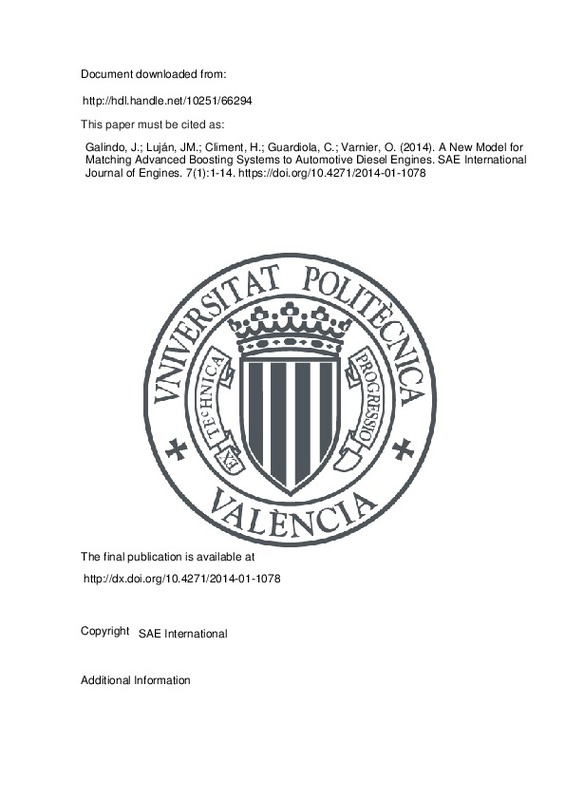JavaScript is disabled for your browser. Some features of this site may not work without it.
Buscar en RiuNet
Listar
Mi cuenta
Estadísticas
Ayuda RiuNet
Admin. UPV
A New Model for Matching Advanced Boosting Systems to Automotive Diesel Engines
Mostrar el registro sencillo del ítem
Ficheros en el ítem
| dc.contributor.author | Galindo, José
|
es_ES |
| dc.contributor.author | Luján, José M.
|
es_ES |
| dc.contributor.author | Climent, H.
|
es_ES |
| dc.contributor.author | Guardiola, Carlos
|
es_ES |
| dc.contributor.author | Varnier, Olivier
|
es_ES |
| dc.date.accessioned | 2016-06-22T08:00:57Z | |
| dc.date.available | 2016-06-22T08:00:57Z | |
| dc.date.issued | 2014 | |
| dc.identifier.issn | 1946-3944 | |
| dc.identifier.uri | http://hdl.handle.net/10251/66294 | |
| dc.description.abstract | [EN] Boosting technologies have been key enablers for automotive engines development through downsizing and downspeeding. In this situation, numerous multistage boosting systems have appeared in the last decade. The complexity arising from multistage architectures requires an efficient matching methodology to obtain the best overall powertrain performance. The paper presents a model aimed to choose the best 2-stage boosting system architecture able to meet required criteria on boosting pressure, EGR ratios for both short and long route loops while respecting the engine thermo-mechanical limits such as in-cylinder pressure, compressor outlet temperature and exhaust manifold temperature. The model includes filling-and-emptying 0D elements together with mean value. The engine model is set in a way that, for given requirements and boosting system layout, calculates in seconds if the requirements will be achieved and the position of variable geometry, waste-gate, EGR and by-pass valves. The model is thus inversed thanks to a new representation of turbine maps that converts the classical iterative matching procedure in straight forward. The model can be also used in a predictive manner to calculate the engine transient response. The model has been calibrated to 3 different turbocharged diesel engines. The model gives good results provided that wave effects are not important. This is the case of compact exhaust manifolds, typically used in turbocharged diesel engines, below 3500 rpm. Tuned intake air lines can be taken into account through a tuning parameter affecting boosting pressure. An example is given in the paper for the matching procedure in a 2-stage, double route EGR, including steady and transient results. | es_ES |
| dc.description.sponsorship | This work has been partially financed by the Univeristat Politècnica de València through the Programa de Apoyo a la Investigación y Desarrollo 2012, project PAID-06-2012 DECOAH. | |
| dc.language | Inglés | es_ES |
| dc.publisher | SAE International | es_ES |
| dc.relation.ispartof | SAE International Journal of Engines | es_ES |
| dc.rights | Reserva de todos los derechos | es_ES |
| dc.subject.classification | MAQUINAS Y MOTORES TERMICOS | es_ES |
| dc.title | A New Model for Matching Advanced Boosting Systems to Automotive Diesel Engines | es_ES |
| dc.type | Artículo | es_ES |
| dc.identifier.doi | 10.4271/2014-01-1078 | |
| dc.relation.projectID | info:eu-repo/grantAgreement/UPV//PAID-06-2012/ | es_ES |
| dc.rights.accessRights | Abierto | es_ES |
| dc.contributor.affiliation | Universitat Politècnica de València. Departamento de Máquinas y Motores Térmicos - Departament de Màquines i Motors Tèrmics | es_ES |
| dc.description.bibliographicCitation | Galindo, J.; Luján, JM.; Climent, H.; Guardiola, C.; Varnier, O. (2014). A New Model for Matching Advanced Boosting Systems to Automotive Diesel Engines. SAE International Journal of Engines. 7(1):1-14. https://doi.org/10.4271/2014-01-1078 | es_ES |
| dc.description.accrualMethod | S | es_ES |
| dc.relation.publisherversion | http://dx.doi.org/10.4271/2014-01-1078 | es_ES |
| dc.description.upvformatpinicio | 1 | es_ES |
| dc.description.upvformatpfin | 14 | es_ES |
| dc.type.version | info:eu-repo/semantics/publishedVersion | es_ES |
| dc.description.volume | 7 | es_ES |
| dc.description.issue | 1 | es_ES |
| dc.relation.senia | 265712 | es_ES |
| dc.contributor.funder | Universitat Politècnica de València | es_ES |







![[Cerrado]](/themes/UPV/images/candado.png)

